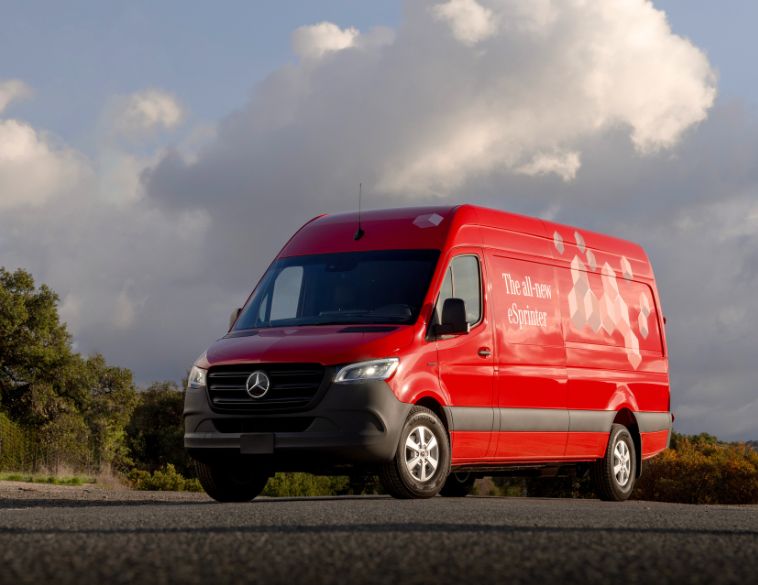Charging infrastructure, range, utility and TCO are all prime considerations.
Recently (and as you’ll read elsewhere on autosphere.ca and see in the April issue of Autosphere Mag), we were invited to try out the new Mercedes-Benz eSprinter in Southern California. While conducting the road test, we thought this environment was a good opportunity to understand what electric delivery vans really represent and where they can be applicable to your fleet.
Impact on strategy
When it comes to BEV delivery vans, the product you buy will impact your fleet strategy, and ultimately, results. In the case of Mercedes-Benz, the eSprinter has been launched alongside its conventional counterpart, giving fleet customers the option to choose which of these better meets their operating requirements.
If you’re looking for a specific BEV vehicle, Mercedes-Benz has gone to great lengths to try and make transitioning to the eSprinter from its conventional counterpart as painless as possible. Although only a single configuration was available at launch, and the all-in cash base price of $107,273, may seem steep, especially compared with the $66,740 base MSRP advertised for its conventional diesel engine counterpart in the same configuration, federal and provincial incentives* can help ease that burden somewhat.
Additionally, with up to 4,250 kg (9,370 lbs) of permissible gross vehicle weight and 13.8 metres of cargo capacity, there is no sacrifice in utility. The biggest challenge will likely come from available charging infrastructure and operational requirements.
Variety of factors
Mercedes notes that charging time will depend on a variety of factors, including the maximum charging capacity available via a wallbox or charging station, as well as the condition of the battery.
This is where active thermal management comes into play. The battery utilized in the eSprinter features LFP (lithium-ferro-phosphate) chemistry and while optimizing the battery’s temperature is key to range and charging efficiency, an onboard heat pump and active thermal management technology helps ensure the battery is able to operate at its maximum efficiency, particularly when it comes time to charge up the eSprinter.
A clever feature, is that when a specific charging station is set in the vehicle’s available onboard MBUX navigation interface, that active thermal management technology goes to work, so that by the time the vehicle arrives at that station, maximum charging efficiency can be achieved.
Again, just how fast it charges depends on the charger and its capacity. For example, a wallbox unit with 7.4KW capacity of Alternating Current (AC) will take 15 hours to fully charge the eSprinter, while one that delivers 9.6 KW capacity can accomplish the same task in 12.5 hours.
It’s also important to note that the high-voltage battery pack in the eSprinter runs exclusively on Direct Current (DC) which means that any AC current will have to be converted via the onboard charger. When using a DC Fast Charger, the current is converted directly by the rectifier at the charging station. By using a DC Fast Charger, Mercedes-Benz says the eSprinter can be 80% charged in a little more than 40 minutes.
Paying for charging
There’s also the question of payment. Fleet operators want to ensure their drivers or representatives can pay for charging services quickly and efficiently. For the eSprinter, the Mercedes me connect and Mercedes me Charge are designed to ensure that. The me Charge solution not only integrates multiple charging point operators across Canada [including ChargePoint, BC Hydro, Electric Circuit and FLO, giving access to over 20,000 locations in the country], it also provides fleets with the estimated cost and availability of charging locations on a specified route, as well as enabling the fleet operator to pay for charging through a single interface, begin a charging session remotely, plus, and perhaps most importantly track charging and payment history.
When it comes to range, while Mercedes-Benz stressed that the eSprinter is capable of a maximum 440 km (273 miles) on a single charge, these results were achieved under strict test conditions**, and real-world driving is likely to be less, particularly in Canada where cold weather can impede battery performance and efficiency.
While our observations here related specifically to the eSprinter, (since that was what we sampled recently), fleets that are considering any type of battery electric van purchase need to account for aspects such as charging infrastructure, range, and Total Cost of Ownership before committing to leasing or purchasing one of these vehicles. They also need to consider the implications for their customers and how EVs could impact delivery frequency, quality of service, convenience, and cost.
*Available incentives include federal IMHEV incentive, plus provincial incentives in B.C., Quebec, Newfoundland & Labrador
**Based on WLTP global test cycle






 MONTRÉAL
MONTRÉAL Full time
Full time


